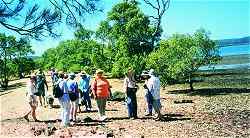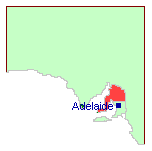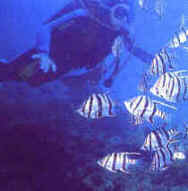Theme: Celebrate the Sea: The Wetlands Connection
Seaweek '96 coordinators: Harry and Jane Breidahl
All along Australia's coastline are areas that are either permanently or temporarily covered by shallow water. These are called coastal wetlands and include mangrove forests, mudflats, saltmarshes, lagoons, lakes and swamps.
Coastal wetlands are very important and productive environments and play a significant part in keeping the coastline stable, productive and clean.
|
Coastal wetlands are home to an amazing diversity of plants, invertebrates, reptiles, fish and birds. They are important breeding grounds for birds and nursery areas for fish. They act as a buffer between the sea and land protecting it from erosion, waves and storms.
|

Mangrove walks were organised for Seaweek in several parts of Australia, this is Lamb Island in Moreton Bay. The mangrove communities of Moreton Bay provide significant nursery areas, that play an important role and contribute greatly to the fishing industry. |
They trap silt, chemicals and other run off from the land, helping to purify the water. They are vital recyclers of nutrients. They provide protection from floods by absorbing and slowly releasing water. They are natural fire breaks. Wetlands are an important part of our life support systems.
The continuing loss or deterioration of wetlands is of global concern. This theme presents the issues of:
- The definition and value of wetlandsWetland ecosystems: harsh environment, tides, temperature and salinityCoastal management issues including: coastal development; draining, acid sulphate soils; dredging; feral plants and animals and blue green algaeWaterbirds: migration; resting and breeding areas; controlling farm pests
- Managing fisheries: home and nursery for many species.
|
|
|
'Taking Seaweek to rural schools’
- Developing a wetlands connection for students in their local area
What
The South Australian President of MESA, an environmental educator, visited rural schools on Yorke Peninsula, South Australia, to assist teachers and students in developing an understanding of the wetland connection in their local area.
Where
Five schools were visited over a five-day period, on the Yorke Peninsula. |

Where is the Yorke Peninsula? |
How

Diving the Yorke Peninsula |
A program of activities were tailored for each class in each school, depending on the location of the school and the requirements of the teachers and students. Over the five days field trips were conducted to freshwater ephemeral wetlands, mangrove communities, intertidal seagrass mudflats, rocky shores and sandy beaches.
|
Some classes combined the field trips with activities back at school where they planted mangrove aquariums or investigated the multiple connections between wetlands and the terrestrial and marine environments.
Why
The visits allowed teachers and students to relate Seaweek to their local area. Yorke Peninsula is surrounded by sea on three sides and many schools are marine focused. The visits promoted a greater understanding of wetland environments and the contributions these communities make to the ecosystem at large. |
|